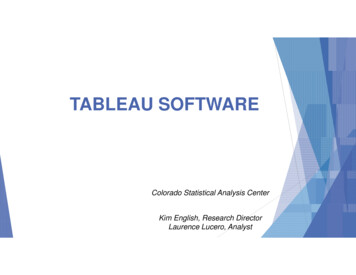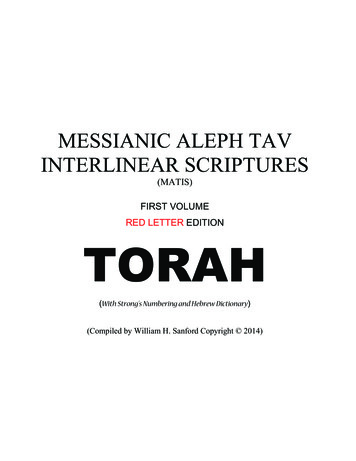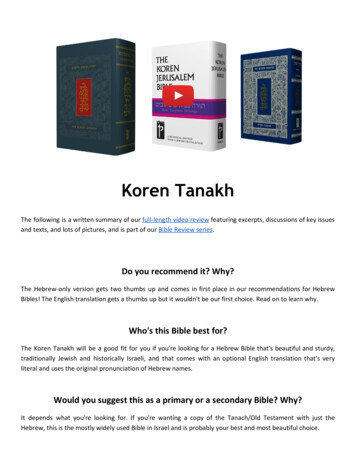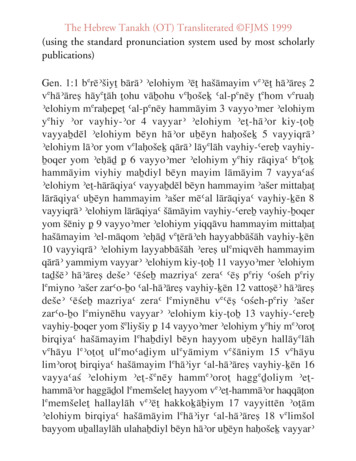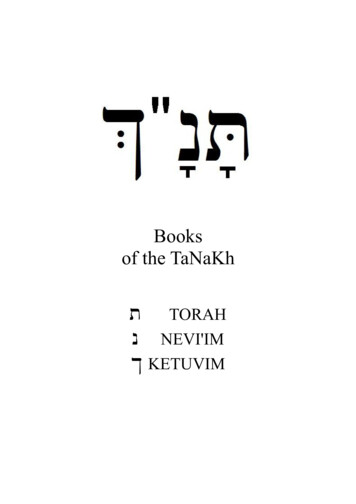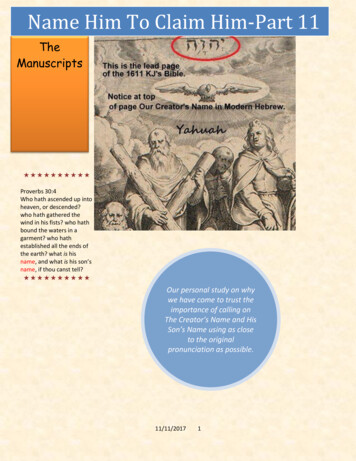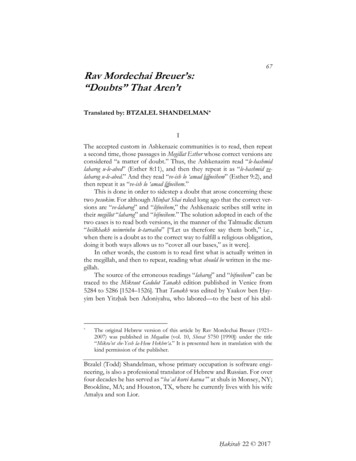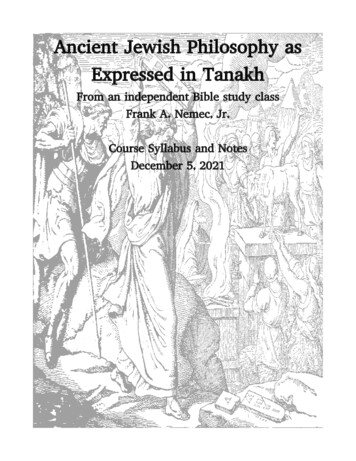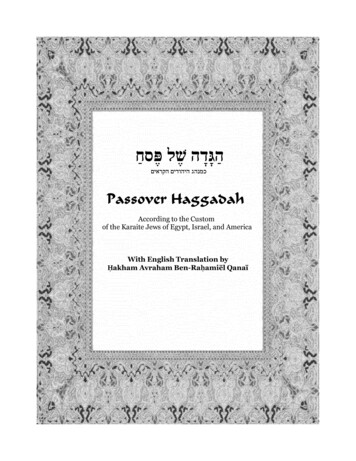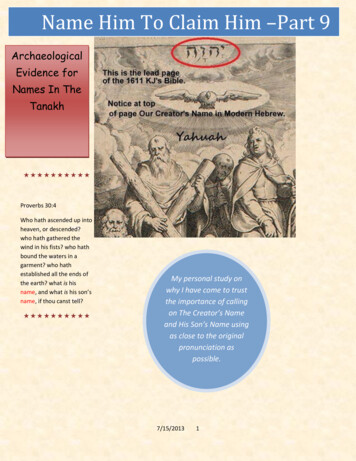
Transcription
Name Him To Claim Him –Part 9ArchaeologicalEvidence forNames In TheTanakh Proverbs 30:4Who hath ascended up intoheaven, or descended?who hath gathered thewind in his fists? who hathbound the waters in agarment? who hathestablished all the ends ofthe earth? what is hisname, and what is his son’sname, if thou canst tell? My personal study onwhy I have come to trustthe importance of callingon The Creator’s Nameand His Son’s Name usingas close to the originalpronunciation aspossible.7/15/20131
Items of DiscussionPart 1The Only Opinion that matters is Yahuah’sPart 2YHWH-The Name The Cover UPPart 3The Tetragrammaton-Wicked or Set apart-Which Came First?Part 4The Hebrew Roots/Scared Name/Messianic MovementPart 5The Kabala/Freemansons and the KJVPart 6The Initial Breaking of The 3rd InstructionPart 7The Tanakh Scriptures on the Importance of Yahuah’s NamePart 8Historical Names In The Tanakh And Eyewitness AccountsPart 9Archaeological Evidence for Names In The TanakhPart 10De-Greecing The Names and Hebrew ThoughtPart 11The ManuscriptsPart 12Jew/Gentile. Who are the Scriptures Talking To?Part 13Is The Way To Salvation through a Specific Name?Part 14Having A Truth Seeking Spirit no matter where the truth leadsPart 15Resources7/15/20132
Part 9Archelogy EvidenceIn this part we will be looking at ancient proof of the validity of the four letters,hwhy to show that is was held to be the Name of the Most High Almighty and nota manifestation of kabbalah.The earliest inscription of His Name is on the Moabite Stone in ancient Hebrewscript, dated 890 BC, however the oldest Scripture text found is called the SilverScroll from the 7th Century with the Aaronic Blessing! Here is an article from theBiblical Archaeological Review Dated April 1983.The very oldest Scriptural text ever found, dating back almost 2,600 years, was found in atiny silver amulet which contains a Seventh Century b.c.e. extract from the Book of Numbers (6:24-26), thepriestly blessing. The rolled up amulet was part of a treasure hard found by a Tel Aviv Universityarcheologist in a First Temple Period family tomb in Yerusalem, Israyl. When this amulet was written, theTemple of Solomon still stood, the heirs of King David still ruled on the throne, and the Dead Sea Scrollswould not be written for another 400 years.7/15/20133
It was three years after its discovery before this fragile amulet could be unrolled by technical experts atthe Israyli Museum. On this amulet the Name of Yahauh could be clearly read. Complete details of thismagnificent find can be read in the 6-28-86 and 8-9-86 issues of The Jerusalem Post and the 6-87 issue ofThe Readers Digest.Bar Mar/Apr 1983News from the Field: The Divine Name Found inJerusalemBy Gabriel BarkayThe Divine Name—the tetragrammaton—yod, he, waw, he—YHVH—Yahweh—LORD—sometimes rendered inEnglish Jehovah—has been found in the Holy City, Jerusalem, for the first time in an archaeological excavation.Dating to the end of the seventh or sixth century B.C., the prayer-like inscription containing the Divine Name wasscratched on a tiny amulet—a rolled-up strip of silver.Jerusalem is the most excavated site in the Holy Land. Indeed, some excavations are still in progress. Nevertheless,the number of inscribed objects from the First Temple Period (which ended with the Babylonian destruction ofJerusalem in 587 B.C.) is very limited. The few inscriptions that have been found were carved in stone or written onpotsherds.The reasons for this paucity are not difficult to understand. Inscriptions on less durable materials like papyrus havelong since disintegrated. Moreover, Jerusalem has been destroyed many times. Each time, a new city was built onthe remains. There are no occupational gaps in its 5,000-year history. And today’s Jerusalem is built on the remainsof the ancient city. It is therefore not surprising that the ancient treasures described in the books of the OldTestament have long since vanished. Even in excavations, precious metals as well as inscriptions are rare. Thismakes our find doubly rare.One burial cave with unusual architectural features held a special surprise. Under one of the burial benches in thiscave we found a large, undisturbed repository—a hollow area hewn under the burial bench. Burial in a repositorylike this was customary in Judah during the Davidic dynasty. Initially the body of the deceased was laid on the hewnstone burial bench inside the cave. Later, to make room for subsequent burials, the bones of the deceased werecollected and placed in the repository, along with the deceased’s burial gifts. In this way, generations that followedwere buried in the same burial cave as their ancestors. This is the meaning of the Biblical expression, “He wasgathered unto his fathers” (e.g. Judges 2:10; 2 Chronicles 34:28). The bones of the deceased were literally placedwith those of the fathers in the repository under the burial bench.The Divine Name that clearly appears in the inscription is composed of the four Hebrew characters written inancient Hebrew script, yod-he-waw-he, commonly written Yahweh and sometimes pronounced Jehovah. TheDivine Name appears in the Old Testament over 6,800 times, yet this is its first appearance on an archaeological7/15/20134
find from the city of Jerusalem—the city where the Lord’s Temple was built—though the Divine Name doesappear on archaeological finds outside Jerusalem (some examples are the Lachish Lettersa, the Arad Letters, finds atKuntillet Ajrud (Khorvat Teiman) in the Sinaib, and cave walls in the Judean hills). The length of the Divine Name inour inscription is 10.9 mm (0.43 inch). The dimensions of the whole strip when unrolled are 97 mm (3.82 inches) inlength, by 27 mm (1.06 inches) in width. The second strip, which is much smaller, was opened later and measures 39mm (1.54 inches) in length, and 11 mm (0.43 inch) in width. It is also covered with densely scratched characters inthe ancient Hebrew script.The dating of the two inscribed, rolled silver strips to the end of the seventh or to the sixth century B.C. is fixedmainly by the archaeological context within which they were discovered. This dating is established primarily by theassociation of the amulets with a rich assemblage of datable pottery totaling more than 300 pieces, found in therepository with the amulets. Additional evidence for the date of the strips is paleographic; the script seems to betypical of the seventh or sixth century B.C. if we compare it to other dated inscriptions.The pottery indicates that the burial cave continued to be used after the destruction of Jerusalem byNebuchadnezzar the Babylonian in 587 B.C. It seems very possible, since most of the objects are dated after 587B.C., that these two silver strips date to the days following the city’s destruction. This may have important historicalimplications.The prophet Jeremiah was an eyewitness to the Babylonian destruction of Jerusalem. Yet neither the book ofJeremiah nor other books of the Bible provide much information about this period in Jerusalem’s history—probablybecause of the trauma and shock caused by the destruction of the city. In the minds of the Jews the holy city ofJerusalem was indestructible. Now they knew differently. One reference in the book of Jeremiah (Jeremiah 41:5)relates that the Jews cherished the physical remains of Jerusalem by visiting the ruins of the Temple. Our silveramulet with the name of the Lord and the other finds from the repository possibly indicate that Jews continued theircontacts with Jerusalem after the destruction of the city and the First Temple.7/15/20135
Ancient Inscription Records Gift To Solomon's TempleNovember/December 1997 issue of Biblical Archaeology Review, pages 28-32.We see here that the Creator's work during the time of Solomon was known by the same Name as it istoday—The House of Yahuah. It was Solomon who built the Temple where this tithe was given. You canread of this in I Kings 6.Two extremely important Hebrew inscriptions have recently surfaced on the antiquitiesmarket. One appears to be a receipt for a donation of three silver shekels to the House ofYahweh, pursuant to an order of the Israelite king. This is the oldest extra-Biblicalmention of King Solomon's Temple ever discovered. The other inscription records thepetition of a widow for some portion of her late husband's property. Both inscriptions,apparently by the same scribe, are written in Old Hebrew, or paleo-Hebrew, the scriptused before the Babylonian Exile. Both are on pieces of pottery, called ostraca becausethey bear an inscription.Only one other extra-Biblical source mentions Solomon's Temple, destroyed by theBabylonians in 586 B.C.E.The text on the first ostracon, which measures about 4 inches wide by 3.5 inches tall(10.9 by 8.6 cm), is only 5 lines and 13 words long. All the words are complete andreadable. See the box for the text and translation.A TEMPLE RECEIPTText:1. K'SR SWK. 'SY2. HW.HMLK.LTT.BYD3. [Z]KRYHW.KSP TR7/15/20136
4. SS.LBYT YHWH [.]5. S3Translation:1. Pursuant to the order to you of Ashya2. hu the king to give by the hand3. of [Z]echaryahu silver of Tar4. shish to the House of Yahweh5. Three shekels.*Brackets indicate that the letter or word has been reconstructed. Half-brackets indicatethat part of the letter or word has been reconstructed.Most of the words are separated from one another by dots acting as word dividers.However, sometimes the word dividers are omitted, such as between LBYT and YHWH,which together are pronounced Beit Yahweh and mean "House of Yahweh."The Temple is designated by the Hebrew term BYT YHWH, many times in the Bible.(Temple only refers to the building, Beit—House refers also the people of Yahweh). ButBYT YHWH had been found complete in only one extra-Biblical inscription, a fadedostracon from Arad with an obscure context, until this newly published ostracon wasrevealed.BYT YHWH has been reconstructed on the inscribed ivory pomegranate that served asthe head of a priestly scepter in Solomon's Temple. divine name would mean "he causesto be, or exist," i.e., "he creates." Amorite personal names after 2,000 B.C. lend supportto the Haupt-Albright view, demonstrating that the employment of the causative stemyahwe "he creates" was in vogue in the linguistic background of early Hebrew.Three-shekel receipt provides evidence of King Solomon's TempleNEW YORK (AP)- Talk about holding on to a receipt.A recently discovered piece of pottery recording a donation to the "House of Yahweh" may containthe oldest mention outside the Bible of King Solomon's Temple.The 3-1/2 by 4-inch artifact is nearly 3,000 years old, dating to a time when kings sent messengesinscribed on pottery. - 11/3/97(AP Photo)BAR Nov/Dec 19977/15/20137
Three Shekels for the LordAncient inscription records gift to Solomon’s TempleBy Hershel ShanksTwo extremely important Hebrew inscriptions have recently surfaced on the antiquities market. One appears to be areceipt for a donation of three silver shekels to the Temple of Yahweh, pursuant to an order of the Israelite king. Thisis the oldest extra-Biblical mention of King Solomon’s Temple ever discovered. The other inscription records thepetition of a widow for some portion of her late husband’s property. Both inscriptions, apparently by the samescribe, are written in Old Hebrew, or paleo-Hebrew, the script used before the Babylonian Exile. Both are on piecesof pottery, called ostraca because they bear an inscription.The text on the first ostracon, which measures about 4 inches wide by 3.5 inches tall (10.9 by 8.6 cm), is only 5 linesand 13 words long. All the words are complete and easily readable. See “A Temple Receipt” below for the text andtranslation. Most of the words are separated from one another by dots acting as word dividers. However, sometimesthe word dividers are omitted, such as between LBYT and YHWH, which together are pronounced Beit Yahweh andmean “house (or temple) of Yahweh.” This omitted word divider may have important implications for the wellknown “Beit David” inscription from Tel Dan (“Reading of ‘Beit David’ Inscription Strengthened”).The Temple is designated by the Hebrew term BYT YHWH, “the house of the Lord,” many times in the Bible. ButBYT YHWH had been found complete in only one extra-Biblical inscription, a faded ostracon from Arad with anobscure context, until this newly published ostracon was revealed.“Yahweh” is clearly present and easily readable on the newly published Temple ostracon.The ostracon describes the silver being donated to the Temple as “silver of Tarshish.” The Bible mentions Tarshishon several occasions, but whether it refers to a place, a kind of ship or a set of trade routes remains a mystery.The New Jerusalem Bible, for example, explains in a footnote at 1 Kings 10:22 that the “meaning [is] uncertain,perhaps a place-name. Or ‘refinery ships’for carrying metal.” The Temple ostracon supports the theory that it was aplace, as most scholars now conclude. But what place? According to 1 Kings 10:22, gold, silver, ivory, apes andpeacocks came from Tarshish. Spain has been suggested as a possible location. However, Harvard paleographerFrank Moore Cross suggests another possibility, based on a reference to Tarshish in a Phoenician inscription foundon Sardinia and known as the Nora Stone.b According to Cross, “Tarshish” there may refer to a Sardinian site wheremetal was smelted, suggesting that the name comes from a root meaning “to smelt.”Several other Biblical texts connect Tarshish with silver. Jeremiah 10:9 mentions that “beaten silver is brought fromTarshish.” In support of the Spanish hypothesis, the authors of the Semitica article note that several classical sourcesrefer to silver production in Spain. “Tarshish silver” may also simply refer to silver of very high quality.The ostracon states that the money is to be given, as commanded by King Ashyahu, to one Zecharyahu fortransmittal to the Temple. Ashyahu appears in a number of inscriptions,c but nowhere with the title of king, and theHebrew Bible lists no king of Judah or Israel by that name. However, the scholars who published the ostraconspeculate that since royal names often appear in more than one form, this name might be another form of Yoash orYehoash (often written in English translations as Joash and Jehoash). These names merely reverse the two elementsin Ashyahu—ash, meaning “has given,” and the theophoric element yahu or yah, signifying Yahweh—yet each ofthese names means “Yahweh has given.” Two kings Yoash or Yehoash are known to have existed: a king of Judahwho reigned from about 835 to 796 B.C., and a king of Israel who reigned from about 803 to 787 B.C.A third possibility exists, that Ashyahu was King Josiah, who reigned over Judah from about 640 to 609 B.C. andinstituted an important religious reform making the Jerusalem Temple the center for all worship of Yahweh. Hisname in Hebrew is composed of the same two elements Y’ash-yah, pronounced Yoshiah. (Y’ash is the imperfectform of ash.)Which, if any, of these kings is referred to in the ostracon as Ashyahu depends on the date of the ostracon. Thearticle’s authors date the handwriting on the ostracon to the latter part of the seventh century B.C., shortly beforethe Babylonian destruction of the Temple. Israeli paleographer Ada Yardeni agrees with a seventh-century B.C. date7/15/20138
for the inscription. On this basis, the two kings named Yoash or Yehoash can be ruled out, as the article’s authors do,leaving only Josiah (or Yoshiah) as a likely possibility.Cross, on the other hand, would date the handwriting more than a century earlier. P. Kyle McCarter, Jr., of JohnsHopkins University agrees with him. If their dating is correct, the two kings named Yoash or Yehoash are bettercandidates. Because the suffix -yahu is associated with Judah—the suffix -yah was used in the northern kingdom ofIsrael—the King Yoash or Yehoash who ruled Judah from 835 to 796 B.C. is McCarter’s pick.The name Zecharyahu, the intermediary mentioned in the ostracon, is well known from other inscriptions and fromthe Bible. BAR readers will recognize the name’s English form: Zechariah or Zachariah.dThe ostracon’s final line contains the single letter shin, the standard abbreviation for shekelim. The number ofshekels is indicated by three strokes. At this early date, before the introduction of coinage, a shekel corresponded toa weight of a little more than 11 grams.Since the amount is the last item recorded, even though “silver of Tarshish” appears earlier, the article’s authorsspeculate that this may have been a standard receipt for a Temple donation. The amount may have been filled inonly at the time of donation. The ostracon was then given to the donor as an official receipt.If one still wants to persist and say that YHWH is a pagan deity, then you nowmust rip out all information dealing with Solomon including the Psalms and David asThe Name YHWH is the same Name that David used, knew and wrote songs to.The above clearly proves that the Temple of King Solomon was called “The Houseof YHWH” and is consistent with the spelling and writing of YHWH’s name inscrolls before this period.The next one is a fragment of the Dead Sea Scrolls-10 Commandments Deut 5.7/15/20139
From the website (6) it states:Dan Rahimi, the ROM's VP for gallery development said that the leather scroll wasthought to date from between 30 and 1 B.C. The scroll was discovered in one of 11caves in 1952. It is not the oldest surviving copy but is the second-or-third-oldest."The parchment is part of the Dead Sea Scrolls found in the ancient remnants of amonastic community in 1947. The scrolls, including the 10 Commandmentsparchment, are dated at close to 30 years before the birth of Christ.The next oldest written document that contains a complete 10 Commandments is1,010 years old and is part of a complete Hebrew Bible that was probably written inCairo and is now in St. Petersburg."The displayed Scroll contains the text of the Ten Commandments from Deuteronomy5 and is the best preserved of all the Deuteronomy manuscripts discovered. A biblicalscroll, it is written in Hebrew and dated to ca. 30 – 1 BCE.7/15/201310
The oldest known text of the Ten Commandments is the Nash Papyrus, discovered inEgypt. A Hebrew text, it dates to 150-100 BCE; the Ten Commandments scroll in thisexhibition dates to 30-1 BCE. In the Nash Papyrus the Ten Commandments arefollowed by the start of the Shema Yisrael prayer ("Hear, O Israel.").7/15/201311
7/15/201312
7/15/201313
7/15/201314
7/15/201315
Let’s look at even earlier evidence - The Lachish Letters.From Wikipedia, the free encyclopediaThe Lachish Letters (Hoshaiah Letters) are a group of letters written in carbon ink in AncientHebrew on clay ostraca. The letters were discovered at the excavations at Lachish (Tel edDuweir).The individual ostraca probably come from the same broken clay pot and were most likelywritten in a short period of time. They were written to Joash, possibly the commanding officerat Lachish, from Hoshaiah, a military officer stationed in a city close to Lachish (possiblyMareshah). In the letters, Hoshaiah defends himself to Joash regarding a letter he either was orwas not supposed to have read. The letters also contain informational reports and requests fromHoshaiah to his superior. The letters were probably written shortly before Lachish fell to theBabylonian army in 588/6 BC during the reign Zedekiah, king of Judah (ref. Jeremiah 34:7).The ostraca were discovered by J.L. Starkey in January–February, 1935 during the thirdcampaign of the Wellcome excavations. They were published in 1938 by Harry Torczyner(name later changed to Naftali Herz Tur-Sinai) and have been much studied since then. Theyare currently located in the British Museum in London, apart from Letter 6, which is onpermanent display at the Rockefeller Museum in Jerusalem, Israel.[1]Text of the LettersLetter Number 2To my lord, Yaush, may YHWH cause my lord to hear tiding(s) of peace today, this very day!Who is your servant, a dog, that my lord remembered his [se]rvant? May YHWH makeknown(?) to my [lor]d a matter of which you do not know.[2]7/15/201316
Letter Number 3Your servant, Hosayahu, sent to inform my lord, Yaush: May YHWH cause my lord to heartidings of peace and tidings of good. And now, open the ear of your servant concerning theletter which you sent to your servant last evening because the heart of your servant is ill sinceyour sending it to your servant. And inasmuch as my lord said "Don't you know how to read aletter?" As YHWH lives if anyone has ever tried to read me a letter! And as for every letter thatcomes to me, if I read it. And furthermore, I will grant it as nothing. And to your servant it hasbeen reported saying: The commander of the army Konyahu son of Elnatan, has gone down togo to Egypt and he sent to commandeer Hodawyahu son of Ahiyahu and his men from here. Andas for the letter of Tobiyahu, the servant of the king, which came to Sallum, the son of Yaddua,from the prophet, saying, "Be on guard!" your ser[va]nt is sending it to my lord. [3]Notes: This ostracon is approximately fifteen centimeters tall by eleven centimeters wide and contains twentyone lines of writing. The front side has lines one through sixteen; the back side has lines seventeen throughtwenty-one. This ostracon is particularly interesting because of its mentions of Konyahu, who has gone down toEgypt, and the prophet. For possible biblical connections according to Torczyner, reference Jeremiah 26:20-23.Letter Number 4May YHW[H] cause my [lord] to hear, this very day, tidings of good. And now, according to everything whichmy lord has sent, this has your servant done. I wrote on the sheet according to everything which [you] sent [t]ome. And inasmuch as my lord sent to me concerning the matter of Bet Harapid, there is no one there. And as forSemakyahu, Semayahu took him and brought him up to the city. And your servant is not sending him thereany[more ---], but when morning comes round [---]. And may (my lord) be apprised that we are watching forthe fire signals of Lachish according to all the signs which my lord has given, because we cannot see Azeqah.[4]Letter Number 5May YHWH cause my [lo]rd to hear tidings of pea[ce] and of good, [now today, now this very da]y! Who isyour servant, a dog, that you [s]ent your servant the [letters? Like]wise has your servant returned the letters tomy lord. May YHWH cause you to see the harvest successfully, this very day! Will Tobiyahu of the royal familyc o me to your servant?[5]Letter Number 6To my lord, Yaush, may YHWH cause my lord to see peace at this time! Who is your servant, a dog, that mylord sent him the king's [lette]r [and] the letters of the officer[s, sayin]g, "Please read!" And behold, the wordsof the [officers] are not good; to weaken your hands [and to in]hibit the hands of the m[en]. [I(?)] know[them(?)]. My lord, will you not write to [them] sa[ying, "Wh]y are you behaving this way? [ . . . ] well-being [. . . ]. Does the king [ . . . ] And [ . . . ] As YHWH lives, since your servant read the letters, your servant has nothad [peace(?)].[6]Letter Number 9May YHWH cause my lord to hear ti[dings] of peace and of [good. And n]ow, give 10 (loaves) of bread and 2(jars) [of wi]ne. Send back word [to] your servant by means of Selemyahu as to what we must do tomorrow. [7]7/15/201317
Lachish LettersDid the Lachish letters reveal the turmoil in Judah just beforethe Babylonian captivity?The discovery of the Lachish Letters in 1935 of eighteen ostraca (clay tablets with writing in ink) written inan ancient Hebrew script, from the 7th century BC reveal important information concerning the last daysof the southern kingdom of Judah.They were discovered at Lachish (Tell ed-Duweir)among the ruins of an ancient guard room just outside the Lachish city gate.Then a few years later three inscribed potsherds were also found at the site, and like theothers, they contained names and lists from the period just before the fall of Jerusalem in586 BC.Most of the letters were dispatches from a Jewish commander named Hoshaiah who wasstationed at an outpost north of Lachish, who apparently was responsible for interpretingthe signals from Azekah and Lachish during the time when the Babylonians came againstJerusalem:Jer 34:7 "when the king of Babylon's army fought against Jerusalem and all the cities ofJudah that were left, against Lachish and Azekah; for only these fortified cities remainedof the cities of Judah."7/15/201318
The ostraca read: "To my lord Ya'osh. May Yahweh cause my lord to hear the news of peace, evennow, even now. Who is your servant but a dog that my lord should remember his servant?'"These final communications which mentioned the political and religious turmoil of the lastdays of Judah reveal the intensity of this time period and confirm that which was written inthe Bible by the prophet Jeremiah.The Lachish Letters are an important discovery in the study of Biblical Archaeology andshed much light on the last days of Judah.British Museum ExcerptLachish Letter IIIsraelite, 586 BCFrom Lachish (modern Tell ed-Duweir), IsraelA letter written on a piece of potteryThis is one of a group of letters written on ostraka (potsherds) found near the maingate of ancient Lachish in a burnt layer which archaeologists have associated with thedestruction of the city by the Babylonians in 586 BC. It is written in ink in alphabeticHebrew. The letters are a poignant record of the city's last days.In 598 BC Nebuchadnezzar, King of Babylon, invaded Judah after it had rebelledagainst him. He captured Jerusalem and took the royal family captive. He installedZedekiah, the former king's uncle, as his choice of ruler. However, rebellion broke outagain. Nebuchadnezzar showed no mercy this time and in 587 BC he beseiged andthen destroyed Jerusalem.This was the period at which this letter was written. It came from an officer namedHosha'yahu who was in charge of a military outpost. He was writing to Ya'osh, militarycommander at Lachish, as the situation worsened.'To my lord Ya'osh. May Yahweh cause my lord to hear the news of peace, even now,even now. Who is your servant but a dog that my lord should remember his servant?'Peace was not to be. Nebuchadnezzar moved on to Lachish and nearby Azekah, thelast two major cities of Judah to be subdued by the Babylonians. There followed alarge-scale deportation of a part of Judah's population. Thus began the exile, a periodof great significance for the Jews spiritually, and one which would profoundly influencelater religious ideology and teaching.7/15/201319
Height: 9 cmWidth: 10 cmExcavated by J. L. Starkey, Wellcome-Marston Research Expedition.ANE 125702Room 57, The Ancient LevantThe British MuseumThe Kings of Israel (all wicked)Jeroboam I (933-911 BC) twenty-two yearsNadab (911-910) two yearsBaasha (910-887) twenty-four yearsElah (887-886) two yearsZimri (886) seven daysOmri (886-875) twelve yearsAhab (875-854) twenty-two yearsAhaziah (855-854) two yearsJehoram (Joram) (854-843) twelve yearsJehu (843-816) twenty-eight yearsJehoahaz (820-804) seventeen yearsJehoash (Joash) (806-790) sixteen yearsJeroboam II (790-749) forty-one yearsZechariah' (748) six monthsShallum (748) one monthMenahem (748-738) ten yearsPekahiah (738-736) two yearsPekah (748-730) twenty yearsHoshea (730-721) nine yearsThe Kings of Judah (8 were good)Rehoboam (933-916 BC) seventeen yearsAbijam (915-913) three yearsAsa (Good) (912-872) forty-one yearsJehoshaphat (Good) (874-850) twenty-five yearsJehoram (850-843) eight yearsAhaziah (843) one year7/15/201320
Athaliah (843-837) six yearsJoash (Good) (843-803) forty yearsAmaziah (Good) (803-775) 29 yearsAzariah (Uzziah) (Good) (787-735) fifty-two yearsJotham (Good) (749-734) sixteen yearsAhaz (741-726) sixteen yearsHezekiah (Good) (726-697) 29 yearsManasseh (697-642) fifty-five yearsAmon (641-640) two yearsJosiah (Good) (639-608) thirty-one yearsJehoahaz (608) three monthsJehoiachim (608-597) eleven yearsJehoiachin (597) three monthsZedekiah (597-586) eleven el/lachish-letters.htmlLachishJoshua 10:31 And Joshua passed from Libnah, and all Israel with him, unto Lachish,and encamped against it, and fought against it.History of LachishToday, Lachish is known as Tell ed-Duweir. Lachish wasonce a highly fortified city that was situated in the lowlandsof Judea, located 30 miles southwest of Jerusalem. Thisonce powerful and strategic city disappeared from theworld’s memory only to reappear in the 20th century.Assyrian warriorsshown impalingJewish prisoners.Part of a relief fromthe palace ofSennacherib. BritishMuseum, London.Credit: ErichLessing/ArtOnce one of Israel’s largest cities, Lachish covers animpressive eighteen acres. Though they have crumbled toa fraction of their original height, the city walls still lookimposing today.At Lachish, archaeologists have discovered the largestgate complex in Israel. The massive double gate includedboth an outer gate structure and an inner gate. Its largesize testifies to the strength and importance of ancientLachish.The Lachish Letters7/15/201321
Resource, NY.Assyrians attack theJewish fortified townof Lachish. Part of arelief from the palaceof Sennacherib atNineveh. BritishMuseum, London.Credit: ErichLessing/ArtResource, NY.Mr. J. L. Starkey and his worthy associates directed theexcavations at Lachish from 1932 to January 10, 1938, andmade many significant discoveries, the most importantbeing twenty-one letters (now known as The LachishLetters) which they found among the ashes and charcoalin the guard room adjoining the outer gate of the city.These letters were written with carbon ink by a certainHoshaiah (Nehemiah 12:32, Jeremiah 42:1, 43:2), asubordinate military officer stationed at an outpost nearJerusalem, to Joash the comma
Tanakh . 7/15/2013 2 Items of Discussion Part 1 The Only Opinion that matters is Yahuah's Part 2 YHWH-The Name The Cover UP . English Jehovah—has been found in the Holy City, Jerusalem, for the first time in an archaeological excavation. Dating to the end of the seventh or sixth century B.C., the prayer-like inscription containing the .

